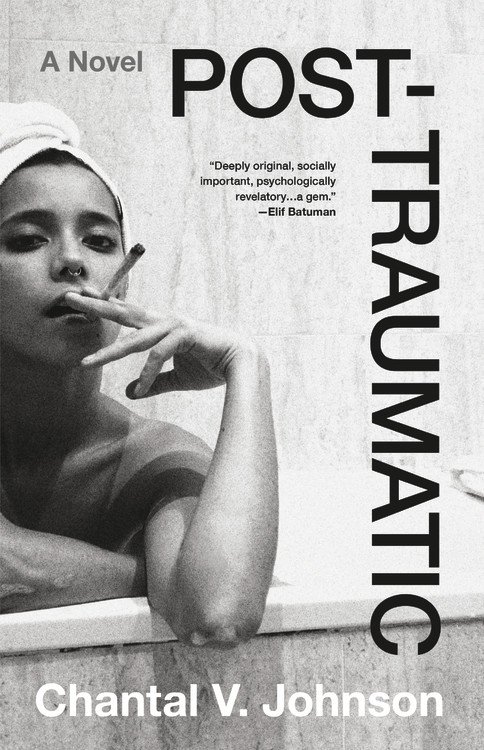
In a late scene in Chantal V. Johnson’s novel Post-traumatic, Vivian, the central character, is confronted by two police officers knocking at her door. She’s a thirty-something Black and Latinx lawyer on hiatus; a concerned family member has called the cops to perform a “wellness check.” Calling the cops is one of the worst things you can do to a distressed person of color, especially one who happens to be trying to extricate herself from the scrutiny of a codependent mother and brother. The visitation sets off Vivian’s fear, anger, and paranoia, as she also happens to reek of weed. Her refusal to open her door is a classic trauma response: both irrational and understandable. And yet the novel raises questions about what we mean by this overused concept, trauma. Some of us have lived through so much pain we are unable to identify experiences as traumatic; others claim commonplace hardships as trauma. In Johnson’s spirited debut novel, this abstraction travels on a spectrum ranging from tragic to comic.
The novel’s third-person voice is closely aligned with Vivian’s troubled double-consciousness. At the novel’s opening, we find Vivian partially masked by her professional identity, a lawyer who advocates for mentally ill patients at a New York City psychiatric hospital. Unfolding in a series of seriocomic scenes, the story begins with a young patient named Melissa attacking a nurse with a butcher knife. The hospital staff fails to act, but Vivian intercedes. “Newbies always underestimate the risk of violence on the children’s ward,” she quips to a colleague, and they both laugh it off. Vivian proves herself capable and even brave in a high-stress situation, one of her few heroic moments in a book animated by the protagonist’s flailing and overreaching.
Johnson tracks Vivian’s self-righteousness as a central tension hardening between her and the psych ward staff. Her career hits a wall as frustrations accumulate, and a definitive defeat occurs when Melissa, now Vivian’s client, is betrayed by her own mother at a routine hearing. After Melissa’s release from the ward is denied, Vivian decides to resign from this thankless job in public service, opting to use her six months’ worth of savings to write a book that the reader could infer to be akin to the one we’re reading. This interlude from routine work life provides Vivian more time to think, get high, and procrastinate, indulging private thoughts that tend toward petty. She becomes fixated on her laxative-addicted nemesis, Pauline, a super-influencer and foodie whose fiancé Vivian aims to seduce at a friend’s wedding. (A plot to divert Pauline by getting her stoned out of her mind on high-THC weed does not go as planned, sparking Vivian’s public meltdown.)
Vivian is at her most coherent (and funniest) when she drops her social-justice-warrior facade, offering sly—if sometimes facile—remarks. When she catches herself referring to an ethnically ambiguous woman as “Persian-looking,” she chastises herself for displaying the “mental laziness” of a white person. In a conversation with her friend Jane about talk therapy, Vivian’s contradictions shine through when she says having a white therapist might be easier: “Seriously, it’s really comforting being around white people! If they ever challenge you, you can always just accuse them of being racist.”
As the plot evolves, the narrative acquires will-she-or-won’t-she suspense about Vivian’s reluctance to go into therapy:
Vivian didn’t need therapy. For one, she didn’t adhere to the biomedical model of mental illness and didn’t want to be diagnosed, labeled, and quantified like her clients. And she didn’t want to hear any overdetermined theories about how she’d been programmed by her dangerous upbringing, either. I am completely sui generis, she thought. Third, she knew the names of all her problems already and believed she could read her way out of them. Also, she had all the jokes. Isn’t the final stage of recovery when you can tell jokes about it? Lastly, she didn’t need to pay someone to make her feel less crazy.
Despite Vivian’s apparent excess of self-awareness, her catastrophic thinking guides her through daily commutes in the city, where she always anticipates the worst that can happen. Threats both real and imagined abound. Her hypervigilance goes hand in hand with her body dysmorphia, as she adheres to a strict exercise regime, ketogenic diets, and the careful counting of calories on snack packets. By degrees, the reader registers that Vivian’s experience of abuse has been converted into a need for control and routine. Her trauma originates from an assault so obliquely described there’s no clear sense of the assailant’s identity or how it transpired. The reader experiences Vivian’s trauma indirectly, through the expressiveness of patients in the ward such as Ms. G, who speaks of being raped “tremendously” back in 1984:
There was nothing to do but listen as Ms. G. cycled through overwhelming events. Vivian knew what this felt like, the rumination vortex. At times she was pulled into it, like when she was stoned, but often she went willingly. It was like she was an archaeologist and her violent past was the dig site: she had to pore over, process, and record every inch of land to get the job done. But as she listened to Ms. G., she started to doubt whether either of them was actually excavating anything. They were kind of just poking around.
After, Ms. G. yawned, turned back to the piano, and launched into “What a Friend We Have in Jesus.”
While Ms. G.’s ruminations feel familiar to Vivian in their hyperbole, Vivian has a more sincere and grounding connection with her friend Jane. They affirm each other in their militant efforts to bring conversations about rape into any social situation, an insistence which stems from a need not to normalize the act itself but to normalize talking about it, making jokes, and bonding over a sense of their shared experience as victims of assault.
Although the novel revolves in some way around abuse, Johnson isn’t interested in indulging the reader with intricate and voyeuristic details of her protagonist’s primary trauma. In Post-traumatic, Johnson approaches the issue by focusing instead on the reverb of trauma that manifests in Vivian’s real and fantasy life. The final chapters sift through Vivian’s desperation to exit the chaos and dysfunction of her family. By this point, she has almost totally retreated from society, unable to go out for her usual run in Prospect Park, haunted by grim hypotheticals of an assault, which she describes as “choke and dump” fantasies. Her deep-seated anxiety and resentment are hardly dispelled as she enters therapy by the novel’s end, but at this point it’s a breakthrough for her to even show up to an appointment.
Post-traumatic recognizes the nature of trauma as a very real, disorderly, and lingering spillage, an invasive stranger all too often mistaken for a companion.
It’s significant that trauma pervades contemporary vocabulary. Given the clinical connotations of the term, though, perhaps it’s important to distinguish trauma, more strictly defined as the psychological fallout of a specific shocking event, from something more generalized and generalizable. Whatever language we use to describe it, there’s no shortage of torment, whether unmediated or abstract, to go around. Will Self’s essay “A Posthumous Shock: How everything became trauma” (Harper’s, 2021) contends that trauma is an atmospheric and intrinsic part of capitalism. Self calls attention to “the ubiquity of traumatogenic technologies in our societies: those of specularity and acceleration, which render us simultaneously unreflective and frenetic.” It’s no big reveal that our digital age exacerbates hysteria. Technology does not liberate us but rather exposes our compulsions and makes us more readily exploitable on a preconscious level—not to mention dumber and prone to disarray and disaffiliation.
Indeed, as we bear witness to Vivian’s unraveling and therapeutic process, it becomes clear that she is affected not just by the traumatic events of her childhood but by the sensorial chaos, speed, and uncertainty of the urban and virtual landscapes in which she must perpetually anticipate the next blows. This more diffuse and collective notion of trauma resembles what Vivian describes to her therapist as suffering:
I don’t know what it means to “have” post-traumatic stress disorder and I don’t want to be limited by it, so I’ll say I’m experiencing those symptoms . . .. But I also feel in touch with myself and with the pain I am experiencing. I feel clear on that point—that I am in pain. I’m suffering, man. And it seems like something worth exploring through art, you know, a particular kind of female suffering. I quit my job! I was a lawyer at a psychiatric hospital, so I know a lot about your field . . . I could’ve been a therapist if only I had more empathy, I’m very judgmental, you know, I don’t like it when people fail, mistakes embarrass me.
Vivian’s comments point not just to a woman dealing with the fallout of abuse, but to a scrupulous personality struggling for self-possession in an unforgiving internet-based culture.
Post-traumatic recognizes the nature of trauma as a very real, disorderly, and lingering spillage, an invasive stranger all too often mistaken for a companion. Vivian’s awareness of her “particular kind of female suffering” is a first step to compassion for herself and other women in her life. It’s also a step toward falling out of love with her suffering.

